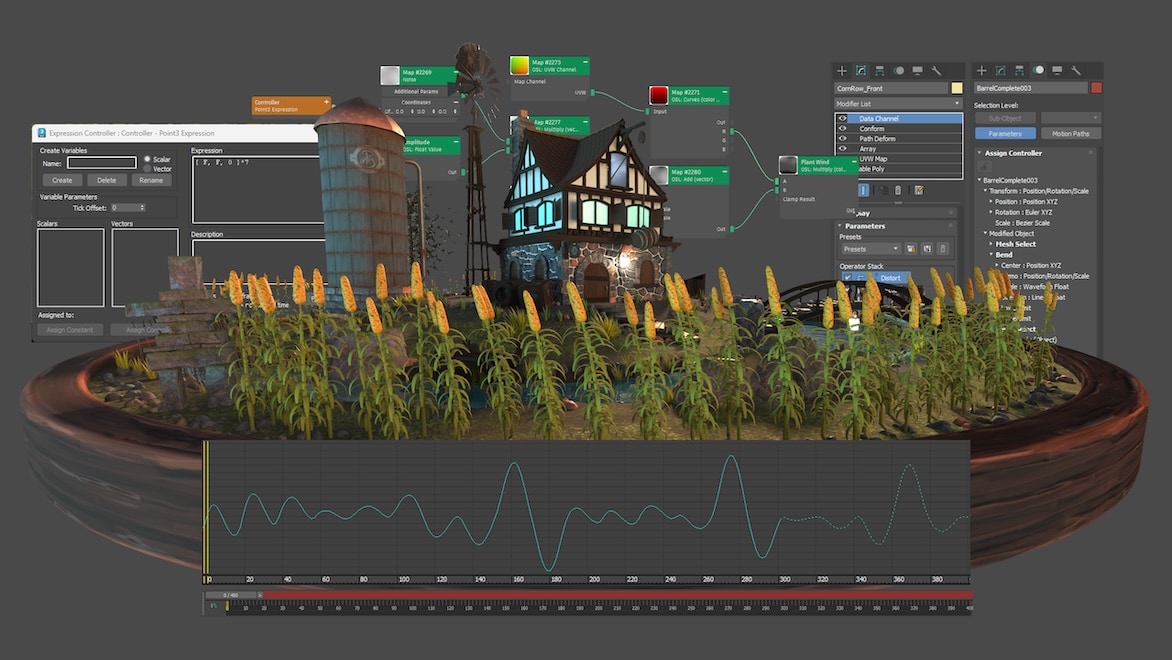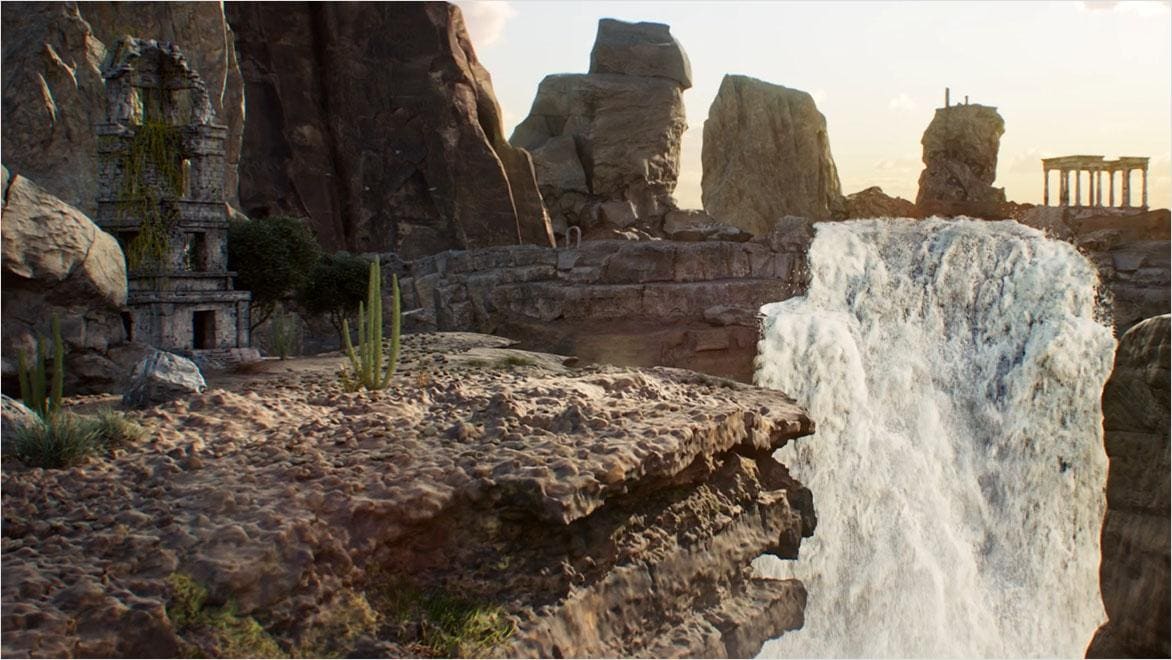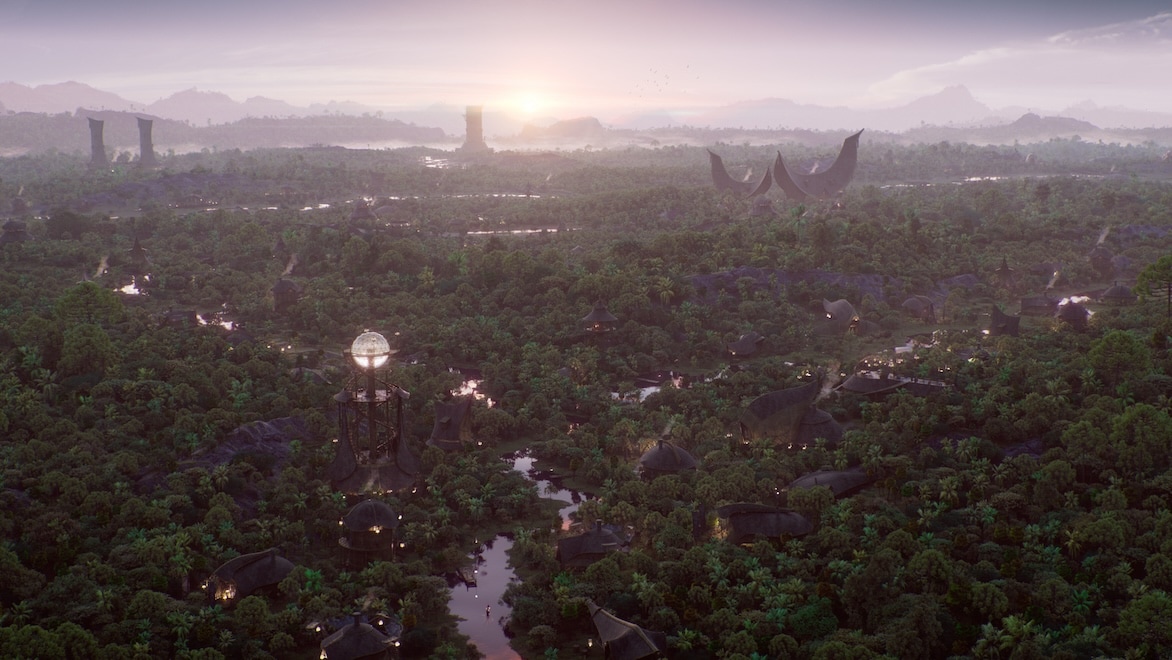& Construction

Integrated BIM tools, including Revit, AutoCAD, and Civil 3D
& Manufacturing

Professional CAD/CAM tools built on Inventor and AutoCAD
Procedural generation is a technique that uses algorithms to bring life to digital content, including landscapes and characters.
The method taps into the limitless potential of code. With just a few lines, you can craft dynamic, ever-evolving worlds that represent your vision and don’t take days to build.
Whether you’re an animator, game developer, or visual effects creator, you can use procedural generation to freely explore the unknown and let your audience’s imagination run wild. Create vast environments, intricate textures, and endless variations that feel organic and unique.
3D procedural generation has evolved over decades. Early examples date back to the 1960s and 1970s, when experiments with algorithmic content creation laid the groundwork for what would eventually become a revolutionary technique.
The idea gained real traction in the gaming world with titles like Rogue, which introduced the notion of randomly generated levels to challenge players with a new experience every time they played.
As technology advanced, so did the sophistication of procedural generation. Games like Minecraft (2011) and No Man’s Sky (2016) pushed the boundaries, captivating millions by offering seemingly infinite worlds—each one unique and ready for exploration.
Today, procedural generation is integral to creating dynamic and diverse content across various digital media and software applications.
Procedural generation uses algorithms to create content that appears handcrafted but is actually produced on the fly.
The process typically starts with a set of rules, parameters, or seeds—small pieces of data that the algorithm uses as a foundation. These seeds are like the DNA of the content that determines everything from the shape of a landscape to the texture of a surface.
As the algorithm runs, it follows these predefined rules to generate complex patterns, structures, and environments.
In a video game, an algorithm might generate a sprawling forest by repeatedly placing trees, each with slight variations in height, color, and placement to create a natural, lifelike appearance.
The algorithm can introduce random variations within the set rules, so the results are often unpredictable and varied, making each iteration feel fresh and unique. By tweaking the rules or changing the seeds, procedurally generated games ensure no two levels are ever quite the same.
Scale your studio’s rendering and simulation capabilities, while equipping artists with powerful modeling and animation tools
Procedural generation offers benefits in many industries, including film, television, gaming, and more. In all these areas, it boasts an array of advantages.
Procedural generation can create vast amounts of content quickly and efficiently, reducing the need for manual design and creation. It’s particularly valuable when you need to generate custom visual effects or environments on a tight deadline or when working on a large-scale project. Speed up production without sacrificing quality.
It provides a high degree of variability and randomness, making each interaction unique. Create responsive and adaptive environments and experiences that keep your audiences engaged.
Procedural generation can adapt content to different hardware specifications, screen sizes, or player preferences. The tool ensures a consistent, optimized experience across devices and platforms, whether users are on a high-end gaming rig or mobile.
Storage requirements for assets are reduced because generated content is created algorithmically at runtime. This can save storage space and reduce load times, making applications faster and more efficient.
Feel empowered to tackle everything from worldbuilding and effects to modular rigging and procedural animation with Bifrost. Bifrost is a powerful procedural 3D content creation tool built into Maya. Technical Directors can build custom graphs in the Bifrost Graph Editor and package them for reuse across shows, scenes, and shots. Artists can also jump right in with a rich library of ready-to-use graphs, making it easy to simulate and create blockbuster-quality effects.
The media and entertainment industry uses procedural generation to create diverse content from seemingly nothing. Applying algorithms, randomization, and preset rules allows you to generate everything from intricate levels and expansive maps to detailed characters and realistic textures.
With procedural generation, you can craft a wide variety of game assets, including life-like terrains, complex level layouts, and detailed 3D models.
Characters, items, and quests can also be procedurally generated so that each gameplay experience is new and engaging. Use the technique to shape immersive soundscapes and adaptive user interfaces to make your games more variable and efficient to develop.
By blending 3D procedural generation and handcrafted content, you can deliver varied and memorable experiences tailored to each game’s unique design and genre.
From the flicker of flames and the drift of snow to the swarm of a bustling crowd, procedural generation is a fantastic tool for visual effects (VFX) professionals.
Generate realistic natural phenomena and virtual environments, helping to bring fantastical visions to life on the big or small screen.
Beyond visual effects, procedural algorithms are also being explored in sound design and music generation, creating soundscapes that adapt to a scene’s mood. In some more experimental cases, the technology is even venturing into scriptwriting.
However, procedural generation shouldn’t replace human creativity and storytelling. While the method doesn’t replace the much-needed creative human touch, it merely supplements your artistry. Use it to preserve the magic of entertainment while ensuring your creations continue to evolve and inspire.
Go from beginner to pro with this comprehensive video series on procedural generation techniques using Bifrost for Maya.
Find out how to model procedurally generated environments in 3ds Max so you can iterate on creative projects more quickly and efficiently.
Explores how Bifrost for Maya can be used to streamline and enhance game development through procedural workflows.
The creation of terrain is a classic example of procedural generation in video games. Algorithms for terrain generation create realistic or fictional landscapes—such as mountains, valleys, and plains—using procedural techniques. Games such as Minecraft and No Man’s Sky use procedural terrain generation to create vast, diverse worlds where each playthrough results in a unique landscape. This provides a sense of exploration and discovery and efficiently generates expansive game worlds without the need for manual design. Procedural generation is equally used to create simulations and effects in film and TV, from cloth and explosions to liquids and snow.
Procedural generation is an algorithmic approach that systematically generates content based on predefined rules and parameters, allowing controlled variability and purposeful design. It’s repeatable and provides structure to content creation. In contrast, random generation relies solely on chance, introducing unpredictability and uncontrolled variability into the content. It is non-repeatable, creating different outcomes each time. The choice between procedural and random generation depends on the need for structured, designed content (procedural) or purely random, unpredictable outcomes (random).
Procedural generation is primarily based on algorithms and predefined rules to create content systematically, but it can also incorporate artificial intelligence (AI) techniques to enhance its capabilities. AI can be used for pattern recognition, adaptability to user interactions, creating entities with complex behaviors, improving content quality, generating narratives, and validating generated content. This combination of procedural generation and AI allows more sophisticated and dynamic content creation in various applications, including video games and simulations, by adding learning, adaptability, complexity, and quality control to the generated content.
Procedural generation is not a single algorithm but a general approach to content creation. It uses algorithms, mathematical formulas, and predefined rules to generate content systematically. The specific algorithms and techniques used in procedural generation vary depending on the type of content being created, whether it’s AI terrain generation, textures, patterns, structures, or more.
Minecraft is a 3D procedurally generated game. Its vast, blocky worlds are created algorithmically, enabling each new game to produce a unique landscape filled with different biomes, structures, and resources.
The first game to use 2D procedural generation was Rogue (1980), which pioneered procedurally generated dungeon levels. Elite (1984) was one of the first games to use 3D procedural generation, applying algorithms to create explorable galaxies on limited hardware.



